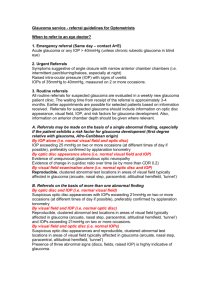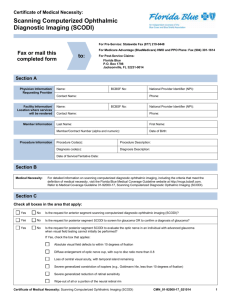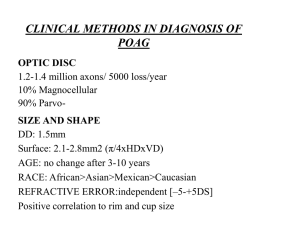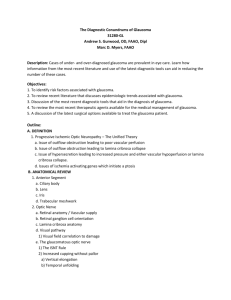Optic Disc and Optic Cup Segmentation for Glaucoma
advertisement
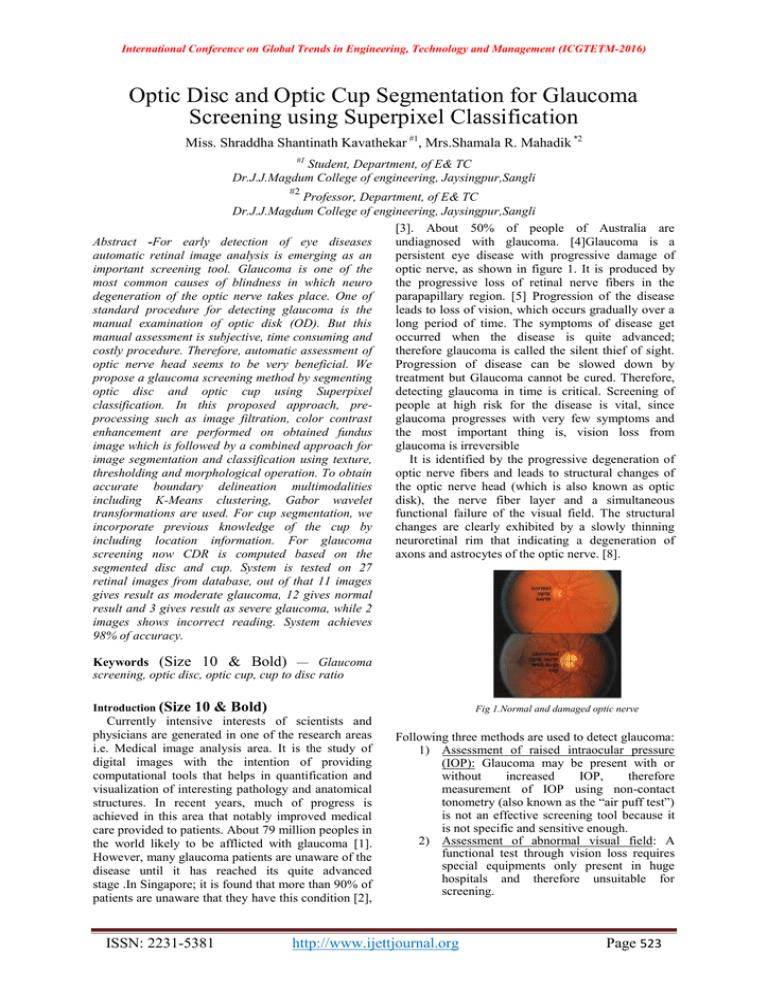
International Conference on Global Trends in Engineering, Technology and Management (ICGTETM-2016) Optic Disc and Optic Cup Segmentation for Glaucoma Screening using Superpixel Classification Miss. Shraddha Shantinath Kavathekar #1, Mrs.Shamala R. Mahadik *2 #1 Student, Department, of E& TC Dr.J.J.Magdum College of engineering, Jaysingpur,Sangli #2 Professor, Department, of E& TC Dr.J.J.Magdum College of engineering, Jaysingpur,Sangli [3]. About 50% of people of Australia are Abstract -For early detection of eye diseases undiagnosed with glaucoma. [4]Glaucoma is a automatic retinal image analysis is emerging as an persistent eye disease with progressive damage of important screening tool. Glaucoma is one of the optic nerve, as shown in figure 1. It is produced by most common causes of blindness in which neuro the progressive loss of retinal nerve fibers in the degeneration of the optic nerve takes place. One of parapapillary region. [5] Progression of the disease standard procedure for detecting glaucoma is the leads to loss of vision, which occurs gradually over a manual examination of optic disk (OD). But this long period of time. The symptoms of disease get manual assessment is subjective, time consuming and occurred when the disease is quite advanced; costly procedure. Therefore, automatic assessment of therefore glaucoma is called the silent thief of sight. optic nerve head seems to be very beneficial. We Progression of disease can be slowed down by propose a glaucoma screening method by segmenting treatment but Glaucoma cannot be cured. Therefore, optic disc and optic cup using Superpixel detecting glaucoma in time is critical. Screening of classification. In this proposed approach, prepeople at high risk for the disease is vital, since processing such as image filtration, color contrast glaucoma progresses with very few symptoms and enhancement are performed on obtained fundus the most important thing is, vision loss from image which is followed by a combined approach for glaucoma is irreversible image segmentation and classification using texture, It is identified by the progressive degeneration of thresholding and morphological operation. To obtain optic nerve fibers and leads to structural changes of accurate boundary delineation multimodalities the optic nerve head (which is also known as optic including K-Means clustering, Gabor wavelet disk), the nerve fiber layer and a simultaneous transformations are used. For cup segmentation, we functional failure of the visual field. The structural incorporate previous knowledge of the cup by changes are clearly exhibited by a slowly thinning including location information. For glaucoma neuroretinal rim that indicating a degeneration of screening now CDR is computed based on the axons and astrocytes of the optic nerve. [8]. segmented disc and cup. System is tested on 27 retinal images from database, out of that 11 images gives result as moderate glaucoma, 12 gives normal result and 3 gives result as severe glaucoma, while 2 images shows incorrect reading. System achieves 98% of accuracy. Keywords (Size 10 & Bold) — Glaucoma screening, optic disc, optic cup, cup to disc ratio Introduction (Size 10 & Bold) Fig 1.Normal and damaged optic nerve Currently intensive interests of scientists and physicians are generated in one of the research areas i.e. Medical image analysis area. It is the study of digital images with the intention of providing computational tools that helps in quantification and visualization of interesting pathology and anatomical structures. In recent years, much of progress is achieved in this area that notably improved medical care provided to patients. About 79 million peoples in the world likely to be afflicted with glaucoma [1]. However, many glaucoma patients are unaware of the disease until it has reached its quite advanced stage .In Singapore; it is found that more than 90% of patients are unaware that they have this condition [2], ISSN: 2231-5381 Following three methods are used to detect glaucoma: 1) Assessment of raised intraocular pressure (IOP): Glaucoma may be present with or without increased IOP, therefore measurement of IOP using non-contact tonometry (also known as the “air puff test”) is not an effective screening tool because it is not specific and sensitive enough. 2) Assessment of abnormal visual field: A functional test through vision loss requires special equipments only present in huge hospitals and therefore unsuitable for screening. http://www.ijettjournal.org Page 523 International Conference on Global Trends in Engineering, Technology and Management (ICGTETM-2016) 3) Assessment of damaged optic nerve head. : Assessment of the damaged optic nerve head is more promising and excellent method of glaucoma screening. Optic nerve head assessment can be done by trained. physicians, who examine the eye fundus using an ophthalmoscope or Heidelberg Retina Tomography (HRT) or the Kowa NonMyd fundus camera are used to obtain digital retina images .[6] But, manual assessment is subjective, time consuming and costly. Therefore, automatic optic nerve head assessment would be very beneficial. One approach for automatic optic nerve head assessment is to use image features to distinguish between glaucoma affected and healthy subjects. [5][7] In this features are normally computed at the image-level. In these methods, feature selection and classification strategy is complicated and challenging. [8] The other strategy is to follow the clinical indicators. There are many glaucoma risk factors which are considered for glaucoma diagnosis such as the vertical cup to disc ratio (CDR) ,disc diameter , ISNT rule, parapapillary atrophy (PPA) , notching , etc. Different ophthalmologists have different point of view about the usefulness of these factors; the CDR is well accepted and commonly used. The Cup to Disc Ratio (CDR) calculated from color retinal fundus camera image is the primary indicator to confirm Glaucoma for a given patient. A larger CDR indicates a higher risk of glaucoma. The CDR is the ratio of the vertical cup diameter (VCD) to vertical disc diameter (VDD) clinically. Precise segmentations of disc and cup have vital importance in CDR measurement. Since 3-D images are not easily available, also the high cost of obtaining 3-D images make it unsuitable for a large-scale screening program and most clinicians still refer 2-D color fundus images for glaucoma screening. (a) (b) Fig 2: Healthy optic nerve (a) and optic nerve in eye with glaucoma (b) A. Optic disc and optic cup The optic nerve head (also called optic disc) is the beginning of the optic nerve and is the part from where ganglion cell axons exit the eye and then they form the optic nerve, through which visual information of the photo-receptors is transmitted to the brain. [9] It is also the entry point for the major blood vessels that supply the retina. In a normal human eye the optic disc carries from 1 to 1.2 million neurons from the eye towards the brain. In ISSN: 2231-5381 Anatomical word the definition of optic disc is, the optic disc is placed 3 to 4 mm to the nasal side of the fovea. It is a vertical oval, which is 1.76mm horizontally wide and 1.92mm vertically long. The disc can be divided into two parts; namely: a central bright zone which is called as optic cup (in short, cup) and a peripheral region called the neuroretinal rim. Astrocytes and nerve fibers together forms the neuroretinal rim while the brighter cup exclusively made up of supporting tissue.Fig.3 shows the major structures of the disc. The ratio of vertical disc diameter to the vertical cup diameter is called as a “cup to disc ratio” (CDR) as shown in fig 4.Generally a CDR with value 0.3 (i.e. the cup occupies 1/3 of the height of the entire disc) is considered normal, and when increased ratio is obtained that means decrease in the quantity of healthy neuro-retinal tissue and hence, that shows glaucomatous change. [9] (a) (b) Fig 3: Major structure of the optic disc I. OPTIC DISC SEGMENTATION A. Background For CDR measurement accurate segmentations of disc and cup is very important. Localization and segmentation of disc has vital importance in many computer aided diagnosis systems that includes glaucoma screening also. The localization means finding a disc pixel, and usually the center. The segmentation evaluates the disc boundary, which is a difficult task due to close spacing of blood vessel, pathological changes around disc, variable imaging conditions, etc. For segmenting optic disc generation of super pixel, K means clustering algorithm, Feature Extraction techniques and morphological operations are used. B. Superpixel Generation Superpixels are local, consistent and provide a convenient primitive to compute local image features. The exact definition of a superpixel is not defined yet but, it is considered as a perceptually meaningful atomic region. A superpixel is a group of pixels that are similar in color, texture, etc., and therefore they belong to the same physical world object.[10] They have been proved to be useful in image segmentations in various images of scene, animal, human etc. Superpixel algorithms group pixels into perceptually meaningful atomic regions which can be used to replace the rigid structure of the pixel grid. http://www.ijettjournal.org Page 524 International Conference on Global Trends in Engineering, Technology and Management (ICGTETM-2016) They reduce the complexity of subsequent processing by capturing redundancy in the image. [11] For an initialization of disc boundary, the superpixel classification is used. The SLIC algorithm uses CIELAB color space instead of RGB color space. RGB model includes about 90% all perceivable colors. The CIE Lab color model encompasses the entire spectrum, including colors outside of human vision. The simple linear iterative clustering algorithm (SLIC) is used in this paper. It aggregate nearby pixels into superpixels in retinal fundus images. SLIC is fast, requires less memory and exhibits excellent boundary attachment to pixels, than other existing super pixel methods. SLIC is also simple because we can use it with only one parameter, i.e., the number of desired superpixels k. clusters) fixed a prior. The main idea is to define k centroid, one for each cluster. The next step is to find each point related to a given data set and relate it to the nearest centroid. The mean of the clusters obtained from the previous step is now given as k new centroid. As a result of repetitive application of these two steps, the k centroid change their location step by step until no more changes take place[12]. In other words centroid will not move again. Final aim of this algorithm is to reduce an objective function (squared error function). ∑KJ=1 ∑XI=1 ||Xij - Cj || (1) j i Where ||X - Cj || is a chosen distance measure between a data point Xij and the cluster centre Cj gives the distance of the n data points from their respective cluster center. SLIC Algorithm: Start Step 1: Initialization Initialize cluster centers Ck = [lk; ak; bk ;xk ;yk] T by sampling pixels at regular grid steps S. Move cluster centers to the lowest gradient position in a 3 *3 neighborhood. Set label l (i) = -1 for each pixel i. Set distance d (i) = ∞ for each pixel i. Repeat Initialize K Number of cluster Calculate Centroid Step 2: Assignment for each cluster center Ck do for each pixel i in a 2S * 2S region around Ck do Compute the distance D between and i. if D < d(i) then Set d (i) =D Set l (i) =k Calculate distance of object from centroid in entire space Grouping based on minimum distance No object Move group Step 3: Update Compute new cluster centers. Compute residual error E. Until E < threshold YES NO A. K means Clustering Algorithm K means is numerous, repetitive, unverified, nondeterministic method i.e. commonly used image segmentation method in computer vision. The wellknown clustering problem can be solved by using this algorithm. To classify the input data points into various groups (called as classes) based on their distance from each other, this algorithm is used. The assumption made in this algorithm is that the data features form a vector space and tries to find natural clustering in them. The procedure is very simple that classify a given data set through a certain number of clusters (k ISSN: 2231-5381 End Fig4. Flowchart of K means clustering algorithm B. Feature extraction In image processing, for detecting edges a linear filter named as Gabor filter is used. There is similarity between Gabor filters and the human visual system about their frequency and orientation representations, and they seem to be especially suitable for texture representation and discrimination. When considered in spatial domain, a 2D Gabor filter is nothing but a Gaussian kernel function modulated by a sinusoidal plane wave. By using dilation and http://www.ijettjournal.org Page 525 International Conference on Global Trends in Engineering, Technology and Management (ICGTETM-2016) rotation method all Gabor filters can be produced from one mother wavelet; therefore they are selfsimilar. Due to blood vessel around disc and cup the clear boundary is normally obtained in cup and disc segmentation. Gabor wavelets can be made useful for blood vessels by tuning it for specific frequencies and orientations. They act as low level oriented edge discriminators and also the background noise of the image is get cleared. Due to directional pattern of vessels, a 2-D Gabor wavelet is best option, since they have directional selectiveness capability of detecting oriented features and fine tuning to specific frequencies. then it indicates glaucoma, otherwise it will be considered as a healthy one. IV. System is tested on 27 retinal images from database, out of that 11 images gives result as moderate glaucoma, 12 gives normal result and 3 gives result as severe glaucoma, while 2 images shows incorrect reading. System achieves 98% of accuracy. From these result we showed that the system gives better result in glaucoma detection in terms of CDR, also computational time is very less. 1) II. OPTIC CUP SEGMENTATION We can use thresholding (also called as binarization) for Optic Cup segmentation Process. This process converts the given image into a thresholded (binarized) image where we can easily obtain our Optic Cup. Thresholding is commonly used for image segmentation since it is very simple and easy to use. During the thresholding process, if the value of individual pixel in an image is greater than some threshold value (assuming an object to be brighter than the background) then that pixels are considered as "object" pixels or as "background" pixels otherwise. This process is known as threshold above. The exactly opposite procedure is known as threshold below; and in the last category, a pixel is labeled as “object" if its value lies in between two thresholds and is known as threshold inside, and opposite of threshold inside is threshold outside. Typically, an object pixel is given a value of “1” while a background pixel is given a value of “0.” Then depending on a pixel's labels each pixel is colored as white or black, and finally a binary image is created. RESULTS 2) 3) Original Image Gray Image Histogram Equalized Image A. Morphological Operations Large number of blood vessels entering the disc may affect boundaries of disc and cup detected from the segmentation methods. Therefore they may not represent the actual shape of the disc and cup. Therefore the morphological operations are employed to reshape the obtained disc and cup boundary. III. 4) Enhanced Image CDR CALCULATION After obtaining the segmented disc and cup, a number of features can be computed. We follow the clinical convention to compute the CDR. As mentioned in the introduction, CDR is an important indicator for glaucoma screening and computed as CDR = area of disc/area of cup (2) 5) LAB color space converted image The computed CDR is used for glaucoma screening. If value of CDR crosses threshold value, ISSN: 2231-5381 http://www.ijettjournal.org Page 526 International Conference on Global Trends in Engineering, Technology and Management (ICGTETM-2016) 6) LAB space image with cluster centers 11) Extracted Disc 7) Segmented Optic Disc 12) 8) Extracted Cup Edge Map Subtracted Image: Final result displayed by the system Area of Optic Disc Area of Optic cup CDR Diagnosis 9) Selection of ROI 10) V. Extracted Image using Gabor ISSN: 2231-5381 7152 3050 0.4265 Moderate glaucoma CONCLUSION In this paper we presented super-pixel classification based optic disc and cup segmentations for glaucoma screening. We concluded that for detection and diagnosis of glaucoma, firstly, optic disk need to be segmented. This paper is presented and evaluated for Glaucoma detection in patients using multimodalities including simple linear iterative clustering (SLIC) algorithm, K-Means and Gabor wavelet transformation of the color fundus camera image to obtain accurate boundary delineation. Using structural features like CDR (Cut to Disc Ratio), the ratio value exceeds 0.6 shall be recommended for further analysis of a patient to the http://www.ijettjournal.org Page 527 International Conference on Global Trends in Engineering, Technology and Management (ICGTETM-2016) ophthalmologist. This shall help in patients worldwide by protecting further vision deterioration through timely medical intervention. With this technique, we have successfully segmented optic disc and optic cup for glaucoma detection. As shown in result chapter system gives better performance in Optic disc and optic cup segmentation and according to segmented optic disc and cup it gives correct reading for CDR calculation and diagnosis .With this system we achieved 98% of accuracy. Besides the successful glaucoma detection we have also increased speed of performance by the use of superpixel i.e. computational time is reduced. REFERENCES [1] [2] [3] World health organization programme for the prevention of blindness and deafness- global initiative for the elimination of avoidable blindness World health organization, Geneva, Switzerland, WHO/PBL/97.61 Rev.1, 1997. S. Y. Shen, T.Y.Wong, P. J. Foster, J. L. Loo,M.Rosman, S.C. Loon, W. L. Wong, S. M. Saw, and T. Aung, “The prevalence and types of glaucoma in malay people: The singapore malay eye study,” Invest. Ophthalmol. Vis. Sci., vol. 49, no. 9, pp. 3846–3851, 2008. P. J. Foster, F. T. Oen, D. Machin, T. P. Ng, J. G. Devereux, G. J. Johnson, P. T. Khaw, and S. K. Seah, “The prevalence of glaucoma in Chinese residents of Singapore: A cross-sectional population survey of the Tanjong Pagar district,” Arch. Ophthalmol., vol. 118, no. 8, pp.1105–1111, 2000. [4] Centre Eye Res. Australia, Tunnel vision: The economic impact of primary open angle glaucoma 2008 [Online]. Available: http://nla.gov.aunla.arc-86954 [5] J. Meier, R. Bock,G.Michelson, L. G. Nyl, and J. Hornegger, “Effects of preprocessing eye fundus images on appearance based glaucoma classification,” in Proc. 12th Int. Conf. Comput. Anal. Images Patterns, 2007, pp. 165–172. R. Bock, J. Meier, G. Michelson, L. G. Nyl, and J. Hornegger, “Classifying glaucoma with image-based features from fundus photographs,” Proc. 29th DAGM Conf. Pattern Recognit. , pp. 355–364, 2007. R. Bock, J. Meier, L. G. Nyl, and G. Michelson, “Glaucoma risk index: Automated glaucoma detection from color fundus images,” Med. Image Anal., vol. 14, pp. 471–481, 2010. [6] [7] [8] G. D. Joshi, J. Sivaswamy, and S. R. Krishnadas, “Optic disk and cup segmentation from monocular color retinal images for glaucoma assessment,” IEEE Trans. Med. Imag., vol. 30, no. 6, pp. 1192–1205,Jun. 2011 [9] J.Cheng, J. Liu, Y.Xu, F.Yin, D.Wong, D.Tao, C.Cheng, T. Aung, and T.Wong,” Superpixel Classification Based Optic Disc and Optic Cup Segmentation for Glaucoma Screening” ieee transactions on medical imaging, vol. 32, no. 6, june 2013 [10] O. Veksler, Y. Boykov, and P. Mehrani, “Superpixels and supervoxels in an energy optimization framework,” in Proc. Eur. Conf. Comput. Vis., 2010, vol. 5, pp. 211– 224 [11] R. Achanta, A. Shaji, K. Smith, A. Lucchi, P. Fua, and S. Susstrunk, “Slic superpixels compared to stateof-the-art superpixel methods,” IEEE Trans. Pattern Anal. Mach. Intell., vol. 34, no. 11, pp. 2274–2281, Nov. 2012. [12] N. Inoue, K. Yanashima, K. Magatani, and T. Kurihara, “Development of a simple diagnostic method for the glaucoma using ocular fundus pictures,” Int. Co nf. of IEEE Eng. in Med. and Bio. Soc., pp. 3355– 3358, 2005 ISSN: 2231-5381 http://www.ijettjournal.org Page 528

